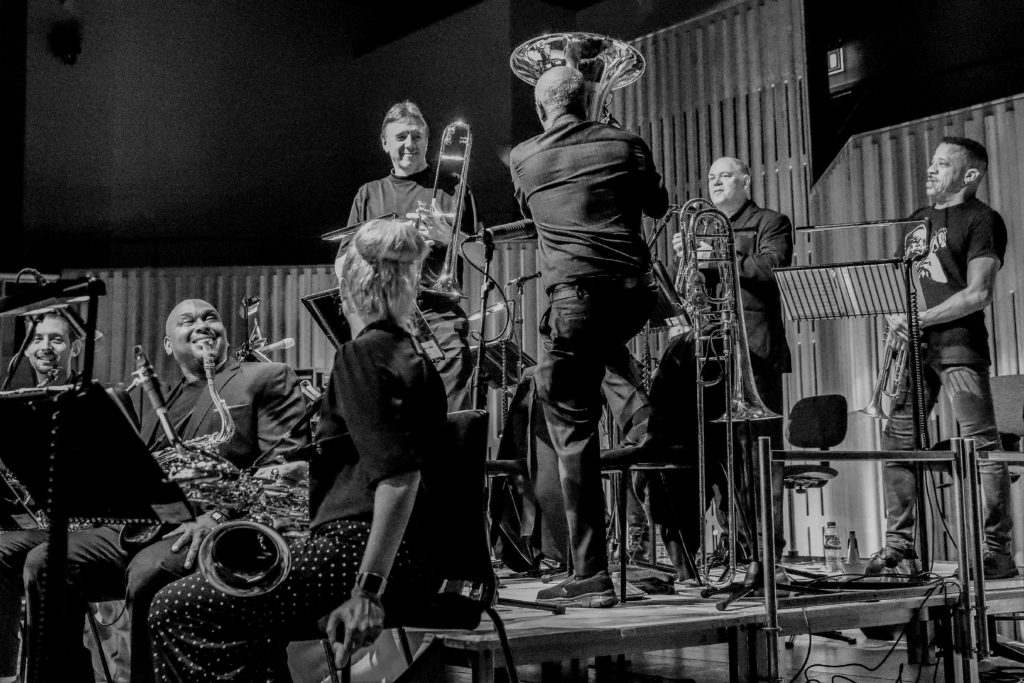Come the 5th of January 2019 it will be exactly 40 years since Charles Mingus passed away. The legendary composer and virtuoso double-bassist is a man who can arguably take a rightful place in the history of jazz alongside fellow greats Louis Armstrong, Charlie Parker, Miles Davis, Ornette Coleman and John Coltrane not least for the particular influence that he has had upon the transformation of bigger orchestral-jazz structures and methods.
And it is because of Charles Mingus’s pioneering work in these areas of creative large forms and the fierce determination and energy of his widow Sue Mingus that his music continues to live on. In 1991 Sue Mingus formed the Mingus Big Band, a revolving and continually evolving roster of 14 musicians who carry on the great man’s rich musical legacy. The ensemble hold true to Charles Mingus’s vision whereby the improvisational liberty that jazz can provide and the compositional complexity of larger scale concert music is combined. And in so doing you do sense that Mingus’s medium-sized ensemble work is finally realised in the form of a more modern-day orchestra.
Last here in 2016 and ahead of a prestigious six night residency at the world-famous Ronnie Scott’s Jazz Club in London’s Soho, the Mingus Big Band makes a triumphant return to the Howard Assembly Room. Set up in their familiar format of piano, double-bass and drums alongside three banks of brass – five saxophones, three trombones and three trumpets – the band play with an explosive freedom and passion of which Charles Mingus would most surely have been proud.
In the first half of a nigh-on two hour performance – bisected by a short interval – the Mingus Big Band provides the sell-out crowd with a startling reminder of Charles Mingus’s genius as they shift easily from the swaggering invention of ‘Jump Monk’ (a song that first appeared on the 1955 live concert recording Mingus at the Bohemia) to a modern arrangement of ‘Invisible Lady’, cementing Mingus’s place in the vanguard of the Third Stream (a musical genre whereby jazz merges with classical music).
Charles Mingus’s generosity as a bandleader was well-regarded and this is replicated in today’s ensemble with ample time and space afforded each individual musician for what are some really quite incredible, improvised solos. Philip Harper is the first to step up to the plate during ‘Jump Monk’ with a raucous, rebellious blast of his trumpet whilst Helen Sung contributes a most phenomenal piano interlude during ‘Sue’s Changes’, a wonderfully spontaneous ballad-come-free jazz piece written by Mingus for his wife.
After the break, the Mingus Big Band takes us on a compelling journey through the bold rhythmic variations of two consecutive movements (from an original total of 26 which if performed in full would take some three hours to complete) from ‘Epitaph’. So called by Charles Mingus as he rightly concluded that it would never be performed in his lifetime, these two movements – ‘Please Don’t Come Back From The Moon (Pinky)’ and ‘O.P.’ (a tribute to one of Mingus’s heroes, the American jazz double-bassist Oscar Pettiford) – provide further insights into his revolutionary expressionism which is brought to fearsome life here by this incredible group of musicians.
Before returning for a richly deserved encore of ‘Self-Portrait in Three Colors’ (from the 1959 studio album Mingus Ah Um), the Mingus Big Band provide a most ironic tribute to their country’s President and his current administration by playing ‘Ysabel’s Table Dance’.
Originally written by Charles Mingus in 1957, this swinging arrangement with its deep Spanish hue and barely contained, wild excitement captures all of Mingus’s deep love for the Mexican border town of Tijuana. It also speaks volubly of the utter devastation that any such dividing wall would create. Nearly 40 years after his death, through the collective efforts of the Mingus Big Band, Charles Mingus’s compositions are still creating deep, imaginative reverberations in the world of contemporary music.
Photos: Simon Godley
More photos from this performance can be found HERE





